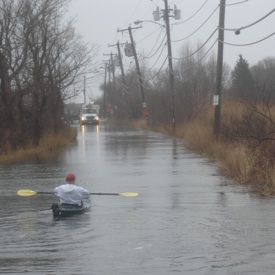Roads and other transportation infrastructure, such as bridges, are critical for evacuating areas before and during emergencies. When conditions are worst, we need our roads and bridges the most.
Communities should have a detailed inventory of the structural components of important access routes (including roads, bridges, and culverts), routine procedures for regularly examining them for damage, and a plan for upgrading critical pieces. When practicable, this infrastructure should be relocated out of the floodplain (for information on identifying your floodplain, see identifying hazards).
When access routes are repaired, alternative designs should be considered to reduce future flood damages, including elevating roads above predicted flood levels and moving roads landward as erosion occurs and/or landforms shift. In addition, appropriate culverts should be enlarged and/or realigned to reduce future flood damage; care must be taken to ensure that these projects do not create any new flood hazards. When protecting critical access routes is impossible, consider relocating them to safer locations.
There may be funding available to help your community in these efforts.
 * Your community needs only 500 points to qualify for reduced flood insurance premiums through the Community Rating System (CRS). For more information (including how to apply for the CRS program), see our Community Rating System (CRS) primer.
* Your community needs only 500 points to qualify for reduced flood insurance premiums through the Community Rating System (CRS). For more information (including how to apply for the CRS program), see our Community Rating System (CRS) primer.
Notes from the folks at CRS:
“Communities can receive credit when new and substantially improved critical facilities are required to be protected from damage or loss of access as a result of the 500-year flood or the flood of record, whichever is higher.”

